CYP Core 3.7 Assignment: Supporting Positive Outcomes for Children
VerifiedAdded on 2021/01/02
|6
|1764
|88
Homework Assignment
AI Summary
This assignment, based on CYP Core 3.7, explores the factors that influence the lives and outcomes of children and young people. It examines social, economic, and cultural factors, including the impact of poverty, and the importance of personal choices and experiences. The assignment identifies positive outcomes practitioners should strive for, emphasizing the design of services around children's needs and the importance of their active participation. It also addresses the potential impact of disability, the significance of positive attitudes towards disability, and different types of support available. Furthermore, it defines equality, diversity, and inclusion, and provides examples of how services can promote these concepts to achieve positive outcomes. The document includes references to relevant literature, offering a comprehensive understanding of the subject matter.
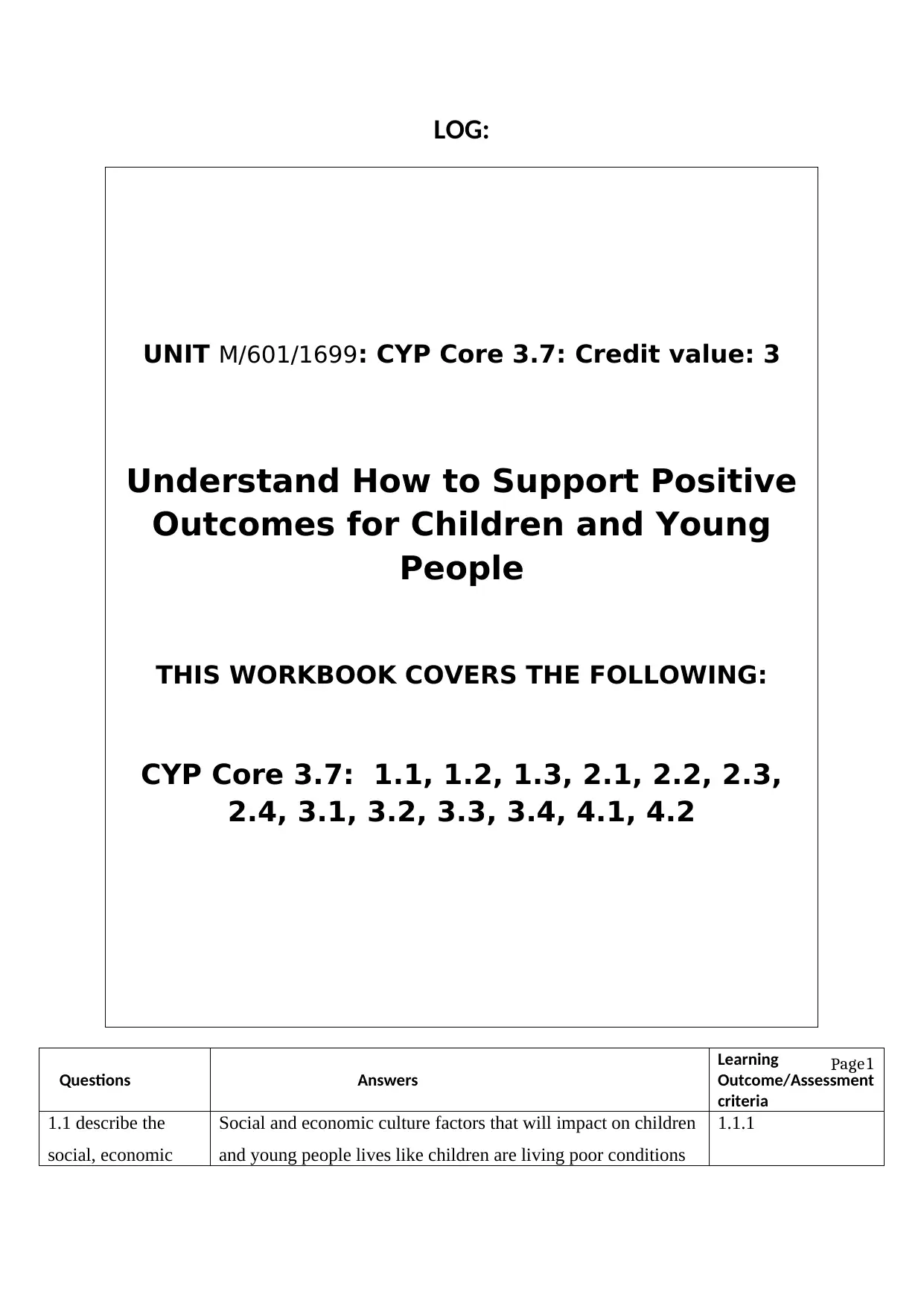
Page1
LOG:
UNIT M/601/1699: CYP Core 3.7: Credit value: 3
Understand How to Support Positive
Outcomes for Children and Young
People
THIS WORKBOOK COVERS THE FOLLOWING:
CYP Core 3.7: 1.1, 1.2, 1.3, 2.1, 2.2, 2.3,
2.4, 3.1, 3.2, 3.3, 3.4, 4.1, 4.2
Questions Answers
Learning
Outcome/Assessment
criteria
1.1 describe the
social, economic
Social and economic culture factors that will impact on children
and young people lives like children are living poor conditions
1.1.1
LOG:
UNIT M/601/1699: CYP Core 3.7: Credit value: 3
Understand How to Support Positive
Outcomes for Children and Young
People
THIS WORKBOOK COVERS THE FOLLOWING:
CYP Core 3.7: 1.1, 1.2, 1.3, 2.1, 2.2, 2.3,
2.4, 3.1, 3.2, 3.3, 3.4, 4.1, 4.2
Questions Answers
Learning
Outcome/Assessment
criteria
1.1 describe the
social, economic
Social and economic culture factors that will impact on children
and young people lives like children are living poor conditions
1.1.1
Paraphrase This Document
Need a fresh take? Get an instant paraphrase of this document with our AI Paraphraser
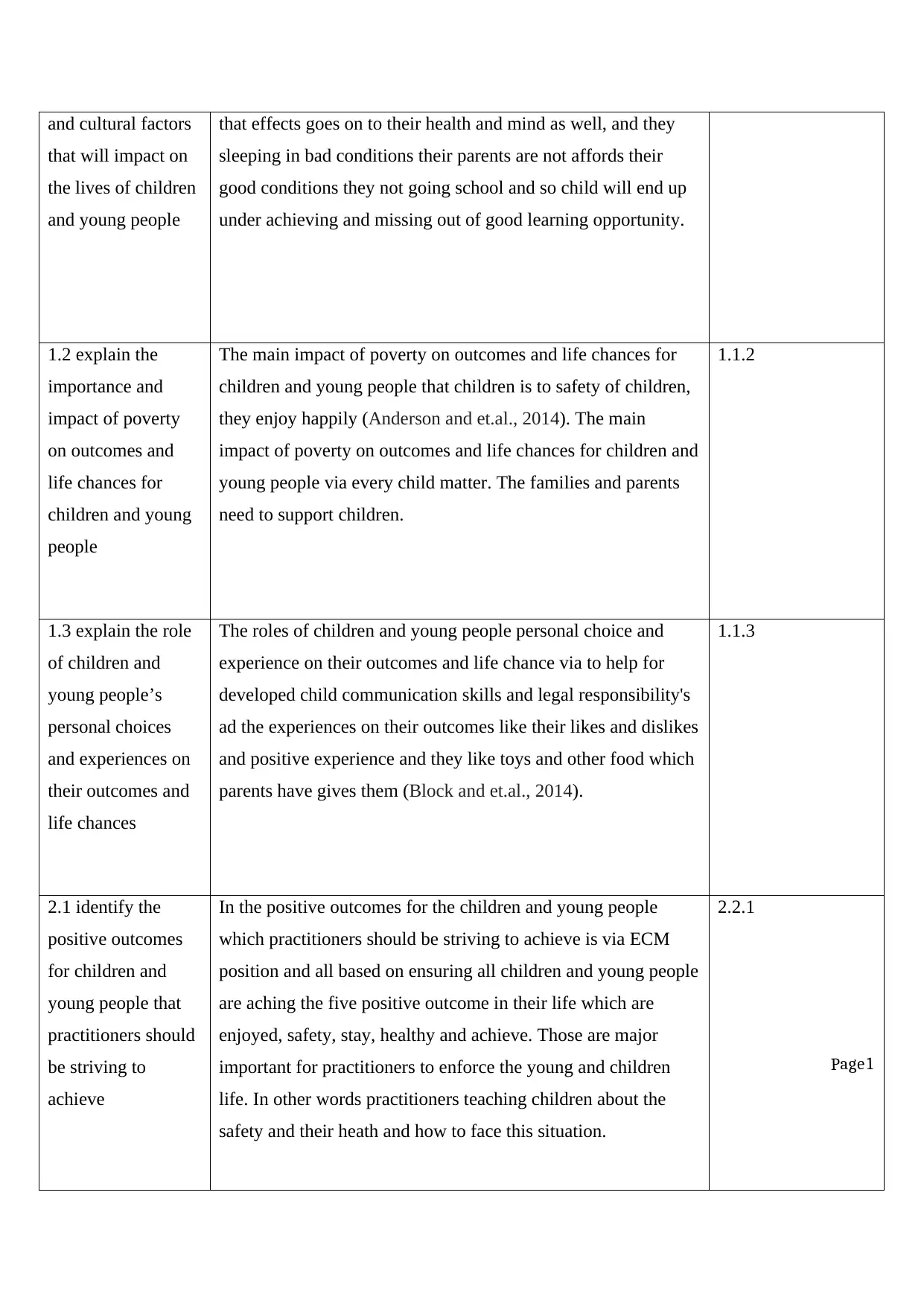
Page1
and cultural factors
that will impact on
the lives of children
and young people
that effects goes on to their health and mind as well, and they
sleeping in bad conditions their parents are not affords their
good conditions they not going school and so child will end up
under achieving and missing out of good learning opportunity.
1.2 explain the
importance and
impact of poverty
on outcomes and
life chances for
children and young
people
The main impact of poverty on outcomes and life chances for
children and young people that children is to safety of children,
they enjoy happily (Anderson and et.al., 2014). The main
impact of poverty on outcomes and life chances for children and
young people via every child matter. The families and parents
need to support children.
1.1.2
1.3 explain the role
of children and
young people’s
personal choices
and experiences on
their outcomes and
life chances
The roles of children and young people personal choice and
experience on their outcomes and life chance via to help for
developed child communication skills and legal responsibility's
ad the experiences on their outcomes like their likes and dislikes
and positive experience and they like toys and other food which
parents have gives them (Block and et.al., 2014).
1.1.3
2.1 identify the
positive outcomes
for children and
young people that
practitioners should
be striving to
achieve
In the positive outcomes for the children and young people
which practitioners should be striving to achieve is via ECM
position and all based on ensuring all children and young people
are aching the five positive outcome in their life which are
enjoyed, safety, stay, healthy and achieve. Those are major
important for practitioners to enforce the young and children
life. In other words practitioners teaching children about the
safety and their heath and how to face this situation.
2.2.1
and cultural factors
that will impact on
the lives of children
and young people
that effects goes on to their health and mind as well, and they
sleeping in bad conditions their parents are not affords their
good conditions they not going school and so child will end up
under achieving and missing out of good learning opportunity.
1.2 explain the
importance and
impact of poverty
on outcomes and
life chances for
children and young
people
The main impact of poverty on outcomes and life chances for
children and young people that children is to safety of children,
they enjoy happily (Anderson and et.al., 2014). The main
impact of poverty on outcomes and life chances for children and
young people via every child matter. The families and parents
need to support children.
1.1.2
1.3 explain the role
of children and
young people’s
personal choices
and experiences on
their outcomes and
life chances
The roles of children and young people personal choice and
experience on their outcomes and life chance via to help for
developed child communication skills and legal responsibility's
ad the experiences on their outcomes like their likes and dislikes
and positive experience and they like toys and other food which
parents have gives them (Block and et.al., 2014).
1.1.3
2.1 identify the
positive outcomes
for children and
young people that
practitioners should
be striving to
achieve
In the positive outcomes for the children and young people
which practitioners should be striving to achieve is via ECM
position and all based on ensuring all children and young people
are aching the five positive outcome in their life which are
enjoyed, safety, stay, healthy and achieve. Those are major
important for practitioners to enforce the young and children
life. In other words practitioners teaching children about the
safety and their heath and how to face this situation.
2.2.1

Page1
2.2 explain the
importance of
designing services
around the needs of
children and young
people.
In this every child and young people have different needs and
requirements and also different barriers which influence to
achieving goals in there life. The ECM provide children to five
needs which children are achieving in their life (Grisham-Brown
and et.al., 2017). Other importance to designing the needs of
children is to motivate them and provide their identity service
from that achieved have achieve goals in their life.
2.2.2
2.3 explain the
importance of active
participation of
children and young
people in decisions
affecting their lives
Importance of active participation of children and young people
In decision affecting their lives are as practitioners communicate
frankly with children parents about their career and their
development and also realize them they have to improve their
children skills, family member always support to improve their
child career and personal development skills which helps toil
maintained their life. Practitioners are helps to need and wants
of child more effectively.
2.2.3
2.4 explain how to
support children and
young people
according to their
age, needs and
abilities to make
personal choices
and experiences that
have a positive
impact on their lives
According to age, needs and abilities to make personal choice
and experience that have positive impact on lives like parents
are taught their children life lesson how they react and how they
interact to other person and according to age, and ability. In
young stage difficult to teach but it also necessary to teach and
encourage them.
2.2.4
3.1 explain the
potential impact of
disability on the
outcomes and life
chances of children
The major effects are those young people and children which
are impacted by disability like blind and people and children
and they are not hearing this effects goes to their learning ability
they are not able to see their teacher and hearing as well. Other
disability young people and children who conscious and they
3.3.1
2.2 explain the
importance of
designing services
around the needs of
children and young
people.
In this every child and young people have different needs and
requirements and also different barriers which influence to
achieving goals in there life. The ECM provide children to five
needs which children are achieving in their life (Grisham-Brown
and et.al., 2017). Other importance to designing the needs of
children is to motivate them and provide their identity service
from that achieved have achieve goals in their life.
2.2.2
2.3 explain the
importance of active
participation of
children and young
people in decisions
affecting their lives
Importance of active participation of children and young people
In decision affecting their lives are as practitioners communicate
frankly with children parents about their career and their
development and also realize them they have to improve their
children skills, family member always support to improve their
child career and personal development skills which helps toil
maintained their life. Practitioners are helps to need and wants
of child more effectively.
2.2.3
2.4 explain how to
support children and
young people
according to their
age, needs and
abilities to make
personal choices
and experiences that
have a positive
impact on their lives
According to age, needs and abilities to make personal choice
and experience that have positive impact on lives like parents
are taught their children life lesson how they react and how they
interact to other person and according to age, and ability. In
young stage difficult to teach but it also necessary to teach and
encourage them.
2.2.4
3.1 explain the
potential impact of
disability on the
outcomes and life
chances of children
The major effects are those young people and children which
are impacted by disability like blind and people and children
and they are not hearing this effects goes to their learning ability
they are not able to see their teacher and hearing as well. Other
disability young people and children who conscious and they
3.3.1
⊘ This is a preview!⊘
Do you want full access?
Subscribe today to unlock all pages.

Trusted by 1+ million students worldwide
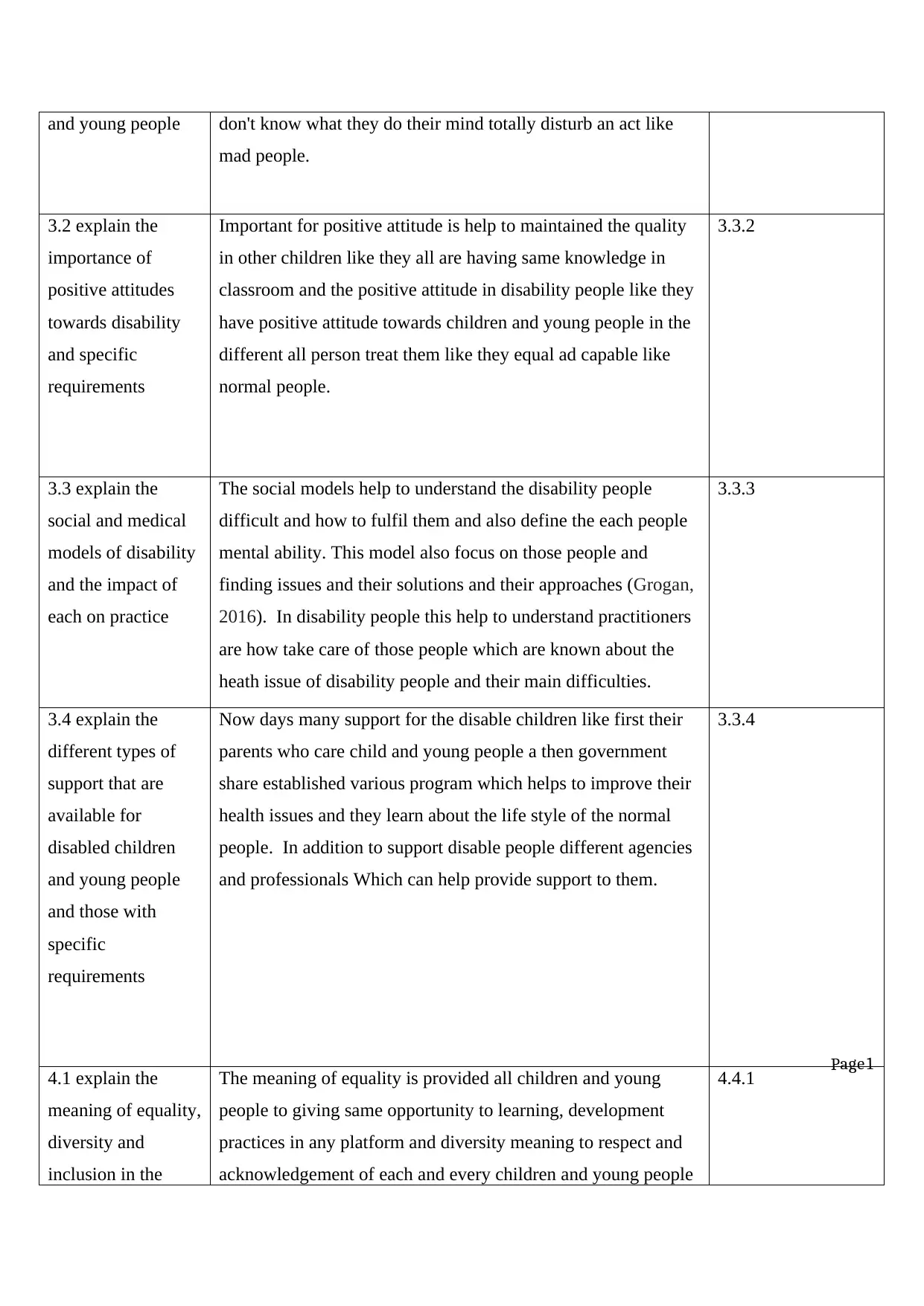
Page1
and young people don't know what they do their mind totally disturb an act like
mad people.
3.2 explain the
importance of
positive attitudes
towards disability
and specific
requirements
Important for positive attitude is help to maintained the quality
in other children like they all are having same knowledge in
classroom and the positive attitude in disability people like they
have positive attitude towards children and young people in the
different all person treat them like they equal ad capable like
normal people.
3.3.2
3.3 explain the
social and medical
models of disability
and the impact of
each on practice
The social models help to understand the disability people
difficult and how to fulfil them and also define the each people
mental ability. This model also focus on those people and
finding issues and their solutions and their approaches (Grogan,
2016). In disability people this help to understand practitioners
are how take care of those people which are known about the
heath issue of disability people and their main difficulties.
3.3.3
3.4 explain the
different types of
support that are
available for
disabled children
and young people
and those with
specific
requirements
Now days many support for the disable children like first their
parents who care child and young people a then government
share established various program which helps to improve their
health issues and they learn about the life style of the normal
people. In addition to support disable people different agencies
and professionals Which can help provide support to them.
3.3.4
4.1 explain the
meaning of equality,
diversity and
inclusion in the
The meaning of equality is provided all children and young
people to giving same opportunity to learning, development
practices in any platform and diversity meaning to respect and
acknowledgement of each and every children and young people
4.4.1
and young people don't know what they do their mind totally disturb an act like
mad people.
3.2 explain the
importance of
positive attitudes
towards disability
and specific
requirements
Important for positive attitude is help to maintained the quality
in other children like they all are having same knowledge in
classroom and the positive attitude in disability people like they
have positive attitude towards children and young people in the
different all person treat them like they equal ad capable like
normal people.
3.3.2
3.3 explain the
social and medical
models of disability
and the impact of
each on practice
The social models help to understand the disability people
difficult and how to fulfil them and also define the each people
mental ability. This model also focus on those people and
finding issues and their solutions and their approaches (Grogan,
2016). In disability people this help to understand practitioners
are how take care of those people which are known about the
heath issue of disability people and their main difficulties.
3.3.3
3.4 explain the
different types of
support that are
available for
disabled children
and young people
and those with
specific
requirements
Now days many support for the disable children like first their
parents who care child and young people a then government
share established various program which helps to improve their
health issues and they learn about the life style of the normal
people. In addition to support disable people different agencies
and professionals Which can help provide support to them.
3.3.4
4.1 explain the
meaning of equality,
diversity and
inclusion in the
The meaning of equality is provided all children and young
people to giving same opportunity to learning, development
practices in any platform and diversity meaning to respect and
acknowledgement of each and every children and young people
4.4.1
Paraphrase This Document
Need a fresh take? Get an instant paraphrase of this document with our AI Paraphraser
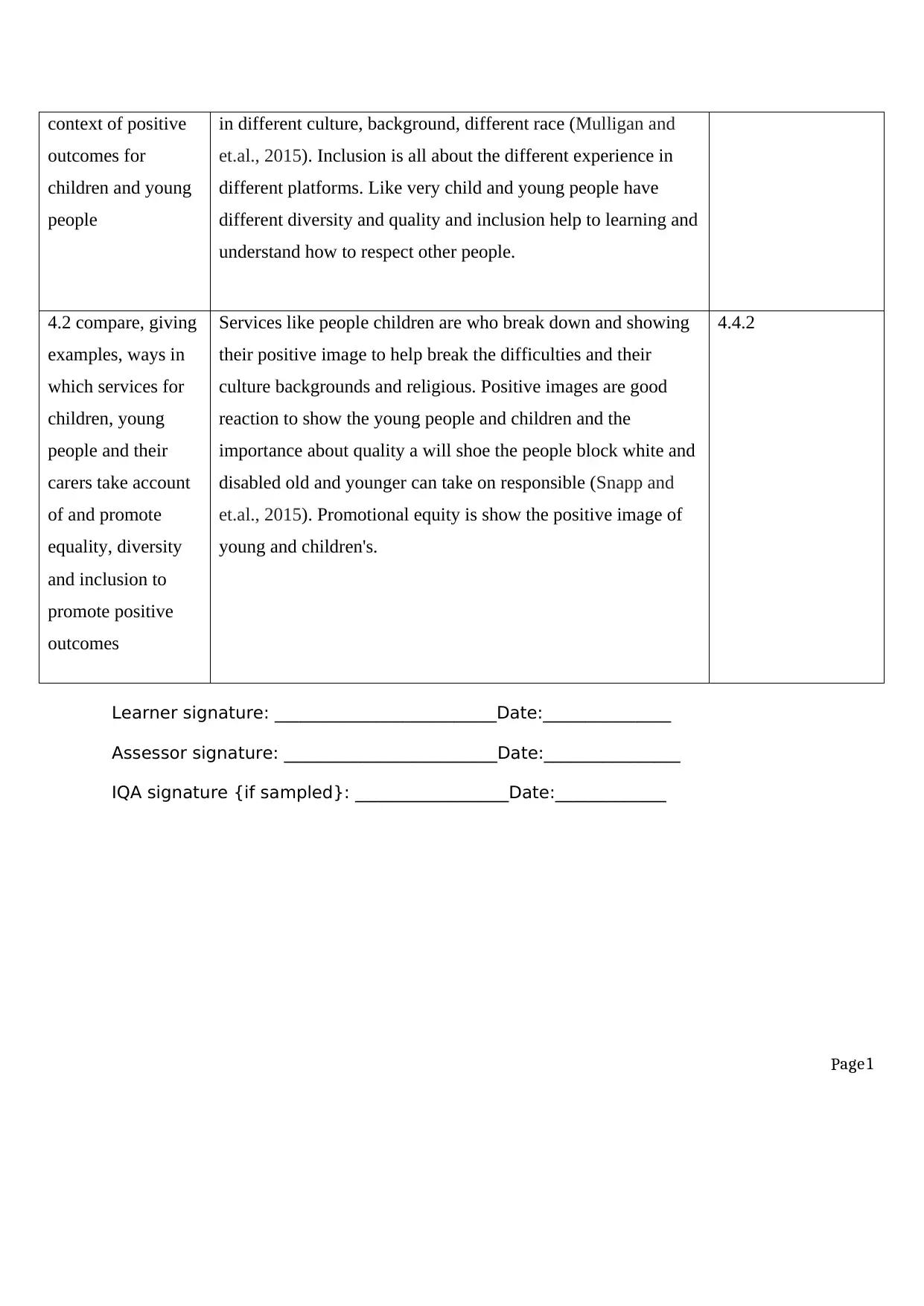
Page1
context of positive
outcomes for
children and young
people
in different culture, background, different race (Mulligan and
et.al., 2015). Inclusion is all about the different experience in
different platforms. Like very child and young people have
different diversity and quality and inclusion help to learning and
understand how to respect other people.
4.2 compare, giving
examples, ways in
which services for
children, young
people and their
carers take account
of and promote
equality, diversity
and inclusion to
promote positive
outcomes
Services like people children are who break down and showing
their positive image to help break the difficulties and their
culture backgrounds and religious. Positive images are good
reaction to show the young people and children and the
importance about quality a will shoe the people block white and
disabled old and younger can take on responsible (Snapp and
et.al., 2015). Promotional equity is show the positive image of
young and children's.
4.4.2
Learner signature: __________________________Date:_______________
Assessor signature: _________________________Date:________________
IQA signature {if sampled}: __________________Date:_____________
context of positive
outcomes for
children and young
people
in different culture, background, different race (Mulligan and
et.al., 2015). Inclusion is all about the different experience in
different platforms. Like very child and young people have
different diversity and quality and inclusion help to learning and
understand how to respect other people.
4.2 compare, giving
examples, ways in
which services for
children, young
people and their
carers take account
of and promote
equality, diversity
and inclusion to
promote positive
outcomes
Services like people children are who break down and showing
their positive image to help break the difficulties and their
culture backgrounds and religious. Positive images are good
reaction to show the young people and children and the
importance about quality a will shoe the people block white and
disabled old and younger can take on responsible (Snapp and
et.al., 2015). Promotional equity is show the positive image of
young and children's.
4.4.2
Learner signature: __________________________Date:_______________
Assessor signature: _________________________Date:________________
IQA signature {if sampled}: __________________Date:_____________
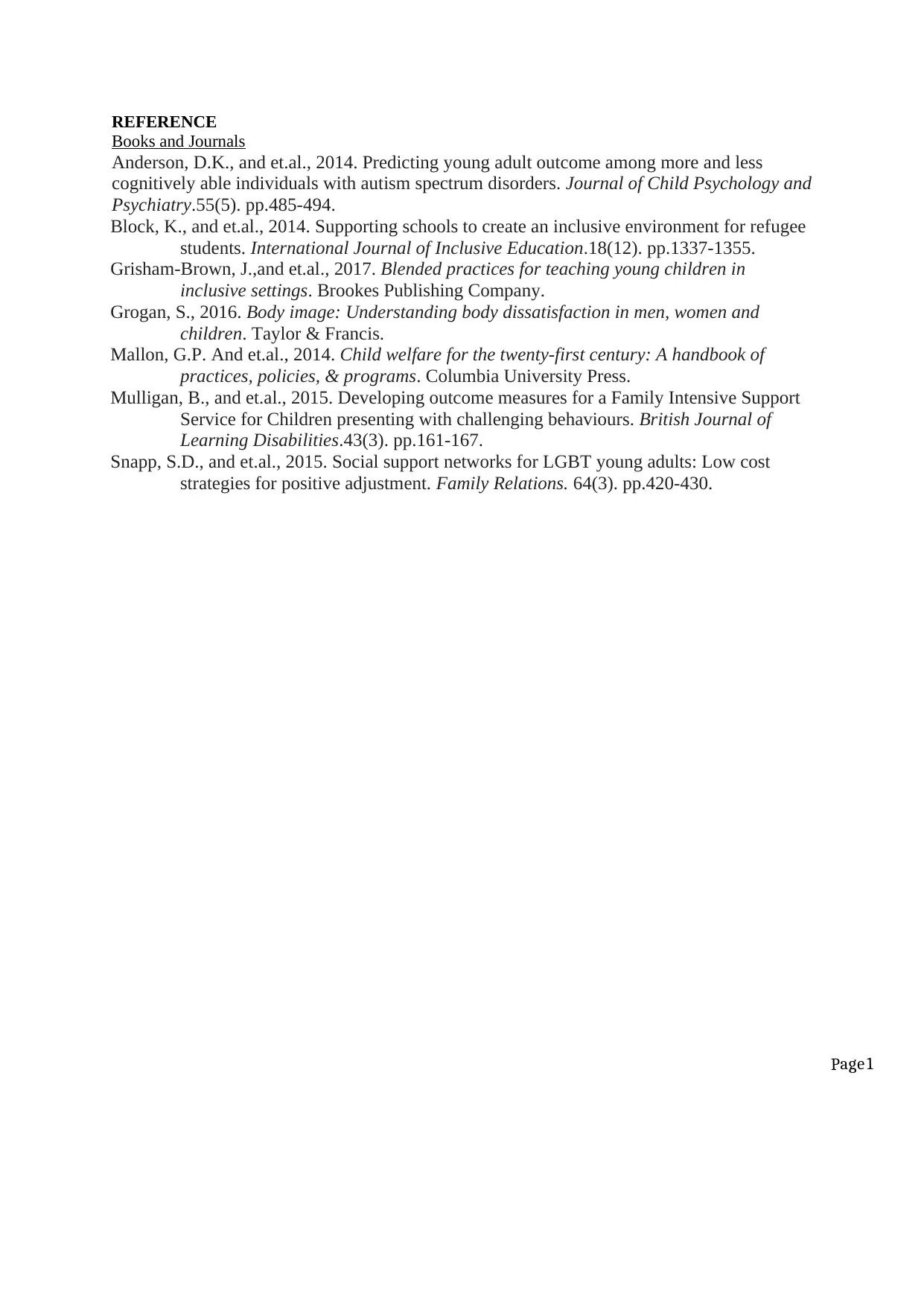
Page1
REFERENCE
Books and Journals
Anderson, D.K., and et.al., 2014. Predicting young adult outcome among more and less
cognitively able individuals with autism spectrum disorders. Journal of Child Psychology and
Psychiatry.55(5). pp.485-494.
Block, K., and et.al., 2014. Supporting schools to create an inclusive environment for refugee
students. International Journal of Inclusive Education.18(12). pp.1337-1355.
Grisham-Brown, J.,and et.al., 2017. Blended practices for teaching young children in
inclusive settings. Brookes Publishing Company.
Grogan, S., 2016. Body image: Understanding body dissatisfaction in men, women and
children. Taylor & Francis.
Mallon, G.P. And et.al., 2014. Child welfare for the twenty-first century: A handbook of
practices, policies, & programs. Columbia University Press.
Mulligan, B., and et.al., 2015. Developing outcome measures for a Family Intensive Support
Service for Children presenting with challenging behaviours. British Journal of
Learning Disabilities.43(3). pp.161-167.
Snapp, S.D., and et.al., 2015. Social support networks for LGBT young adults: Low cost
strategies for positive adjustment. Family Relations. 64(3). pp.420-430.
REFERENCE
Books and Journals
Anderson, D.K., and et.al., 2014. Predicting young adult outcome among more and less
cognitively able individuals with autism spectrum disorders. Journal of Child Psychology and
Psychiatry.55(5). pp.485-494.
Block, K., and et.al., 2014. Supporting schools to create an inclusive environment for refugee
students. International Journal of Inclusive Education.18(12). pp.1337-1355.
Grisham-Brown, J.,and et.al., 2017. Blended practices for teaching young children in
inclusive settings. Brookes Publishing Company.
Grogan, S., 2016. Body image: Understanding body dissatisfaction in men, women and
children. Taylor & Francis.
Mallon, G.P. And et.al., 2014. Child welfare for the twenty-first century: A handbook of
practices, policies, & programs. Columbia University Press.
Mulligan, B., and et.al., 2015. Developing outcome measures for a Family Intensive Support
Service for Children presenting with challenging behaviours. British Journal of
Learning Disabilities.43(3). pp.161-167.
Snapp, S.D., and et.al., 2015. Social support networks for LGBT young adults: Low cost
strategies for positive adjustment. Family Relations. 64(3). pp.420-430.
⊘ This is a preview!⊘
Do you want full access?
Subscribe today to unlock all pages.

Trusted by 1+ million students worldwide
1 out of 6
Related Documents
Your All-in-One AI-Powered Toolkit for Academic Success.
+13062052269
info@desklib.com
Available 24*7 on WhatsApp / Email
![[object Object]](/_next/static/media/star-bottom.7253800d.svg)
Unlock your academic potential
Copyright © 2020–2026 A2Z Services. All Rights Reserved. Developed and managed by ZUCOL.





